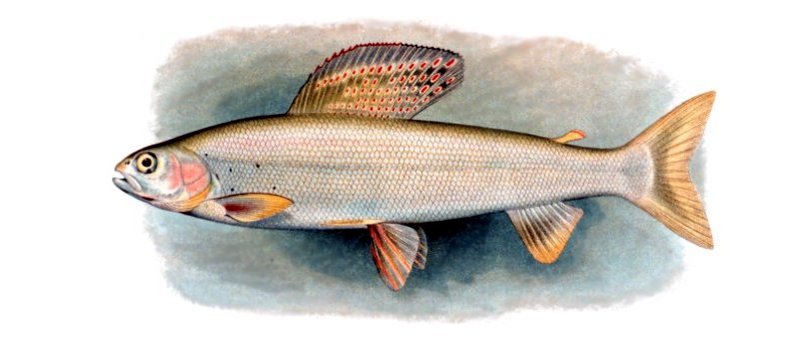Arctic Grayling (Thymallus arcticus) - Wiki Arctic grayling
From Wikipedia, the free encyclopedia
[Photo] Arctic grayling (Thymallus arcticus arcticus). From: The Fishes of Alaska. Bulletin of the Bureau of Fisheries no. 26. Washington, D.C.: U.S. Government Printing Office, 1909.
The Arctic grayling (Thymallus arcticus) is a species of freshwater fish in the salmon family (family Salmonidae) of order Salmoniformes. It comprises five subspecies, including the Arctic grayling proper (T. arcticus arcticus).
It is native to the Nearctic and Palearctic ecozones, T. arcticus arcticus being widespread throughout the Arctic and Pacific drainages in Canada, Alaska, and Siberia, as well as the upper Missouri River draining in Montana, and formerly in the Great Lakes region, where it has become extinct. Other subspecies have narrower ranges, T. arcticus baicalensis, for example, being restricted to Lake Baikal and its drainage in Russia and T. arcticus grubii to the Amur basin in east Asia.
Several life history forms of Arctic grayling occur: fluvial populations that live and spawn in rivers; lacustrine populations that live and spawn in lakes; and adfluvial populations that live in lakes and spawn in tributary streams.
The upper Missouri River basin population once merited a high priority for Endangered Species Act listing by the US Fish & Wildlife Service. This unique southernmost population is now extinct in all areas of the upper Missouri River basin with the exception of the Big Hole River watershed. In preparation for an ESA listing, US FWS began implementing a "Candidate Conservation Agreement with Assurances." This agreement would protect cooperating landowners from being prosecuted under the ESA "takings" clause so long as they fulfill specific obligations spelled out in a contractual agreement intended to restore this dwindling population. The CCAA is now in doubt for the following reason. Recently (25April07), however, US FWS removed Big Hole River grayling from ESA candidacy. The rationale was based on (1) genetically lumping the fluvial population with more common lake-dwelling populations; and (2) arguing that the Montana grayling populations are insignificant and their loss would not matter given thriving populations in Alaska. See Montana Grayling Genetics.
T. arcticus arcticus grows to a maximum recorded length of 76 cm (30 in) and a maximum recorded weight of 3.8 kg (8.4 lb); the other subspecies range in maximum length from 30 to 44 cm (12???17 in), with maximum weights as low as one-third that of the Arctic grayling proper. Of typical Thymallus appearance, the Arctic grayling is distinguished from the similar grayling (T. thymallus) by the absence of dorsal and anal spines and the presence of a larger number of soft rays in these fins. There is a dark longitudinal line between the pectoral and pelvic fins, and the flanks may possess a pink iridescence. Some subspecies exhibit distinctive coloration, T. arcticus baicalensis, for example, being darker in color with two wide vertical bars of lighter shade along its body. T. arcticus arcticus has been recorded as reaching an age of 18 years.
The Arctic graylings occur primarily in cold waters of mid-sized to large rivers and lakes, returning to rocky streams to breed, although T. arcticus baicalensis remains in shallow waters for its entire life. The various subspecies are omnivorous, crustaceans, insects, and fish eggs and larvae forming the most important food items; larger T. arcticus arcticus individuals feed on adult fish and even small aquatic mammals, such as lemmings, while the immature fish feed on zooplankton, including insect larvae.
Spawning takes place in the spring, when the fish seek the shallow areas of rivers with fine sand substrate and moderate current. The males then establish individual territories and court the females by flashing their colourful dorsal fins; the fins are also used to brace receptive females during the vibratory release of milt and roe. As these fishes are nonguarders, the eggs are left to mix with the substrate. Although the graylings do not excavate nests, the highly energetic courtship and mating tends to kick up silt and cover the eggs. The eggs are small (approximately 3 mm in diameter) and hatch after two to three weeks. The hatched larvae remain in the substrate until they reach a length of around 12???18 mm (0.5???0.7 in), at which time they form shoals at the river margins. The fry grow quickly during their first year or two of life.
With the grayling proper (T. thymallus), the T. arcticus arcticus is one of the economically important Thymallus species, being raised commercially and fished for sport.
Sensitive to pollution, the Arctic grayling has disappeared from the North American Great Lakes, but as it remains widespread elsewhere it is not listed on the IUCN Red List of threatened species.
Obsolete synonyms for T. arcticus arcticus include T. montanus, T. signifer, and T. tricolor. The species is also known as the Alaska grayling.
Several submarines and patrol boats of the United States Navy have been named USS Grayling after this species.
Subspecies
T. arcticus arcticus (Pallas, 1776) ??? Arctic grayling
T. arcticus baicalensis (Dybowski, 1874) ??? Baikal black grayling
T. arcticus grubii Dybowski, 1869 ??? Amur grayling
T. arcticus mertensii Valenciennes, 1848
T. arcticus pallasi Valenciennes, 1848 ??? East Siberian grayling
T. yaluensis is sometimes considered a further subspecies of T. arcticus. It may indeed be identical to T. arcticus grubii.
http://en.wikipedia.org/wiki/Arctic_grayling
| The text in this page is based on the copyrighted Wikipedia article shown in above URL. It is used under the GNU Free Documentation License. You may redistribute it, verbatim or modified, providing that you comply with the terms of the GFDL. |
